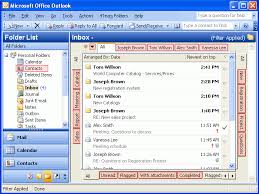MS OUTLOOK
Introduction to Microsoft Outlook:
Microsoft Outlook is a widely used personal information
manager, primarily used for email communication, but it also includes features
for managing calendars, contacts, tasks, and more. It's part of the Microsoft
Office suite and is available for Windows, macOS, iOS, and Android.
Overview of Outlook Tabs:
Outlook typically consists of several tabs, each serving a
specific purpose. These tabs are designed to organize the various
functionalities of the application, making it easier for users to navigate and
access different features. The main tabs in Outlook are:
1. Home Tab:
This is the default tab that appears when you open Outlook. It contains the most commonly used features for managing emails, such as composing new messages, replying to or forwarding emails, deleting or moving messages, and managing your calendar.
2. Send/Receive Tab:
This tab is used for manually
sending and receiving emails. It allows you to synchronize your Outlook account
with the mail server to ensure that you have the latest emails in your inbox
and that any outgoing emails are sent promptly.
3. Folder Tab:
The Folder tab provides tools for
managing email folders and organizing your inbox. You can create new folders,
rename existing folders, delete folders, and apply rules to automatically sort
incoming emails into specific folders.
4. View Tab:
This tab allows you to customize the
appearance of your Outlook interface. You can change the layout of your inbox,
adjust the reading pane settings, apply filters to your emails, and customize
the ribbon to display the features you use most frequently.
5. Developer Tab:
This tab is primarily used by software
developers to create custom applications and add-ins for Outlook. It provides
tools for accessing the Outlook object model and writing code to automate tasks
or extend the functionality of the application.
6. Add-ins Tab:
The Add-ins tab allows you to manage
add-ins for Outlook. Add-ins are third-party extensions that provide additional
features and functionality beyond what is included in the standard Outlook
application. You can use this tab to install, enable, disable, or remove
add-ins as needed.
7. Options Tab:
The Options tab contains settings and
preferences for customizing the behavior of Outlook. You can configure email
accounts, set up automatic replies, adjust privacy settings, manage email
signatures, and customize other aspects of the application to suit your needs.
Detailed Explanation of Each Tab:
1. Home Tab:
- New: Clicking on this button allows you to compose a new email message, appointment, meeting, contact, or task.
- Delete Deletes the selected email, contact, appointment, or task.
- Respond : Provides options for responding to or forwarding emails.
- Move: Allows you to move the selected item to a different folder.
- Tags: Lets you categorize or flag emails, contacts, appointments, or tasks for better organization.
- Find: Provides tools for searching your mailbox for specific emails, contacts, appointments, or tasks.
2. Send/Receive Tab:
- Send/Receive All Folders: Initiates a manual send/receive operation for all email accounts and folders.
- Send/Receive Groups: Allows you to customize send/receive settings for specific email accounts or folders.
- Download Preferences: Lets you specify which items to download for offline use.
- Send/Receive Settings: Provides advanced options for configuring send/receive settings.
3. Folder Tab:
- New Folder: Creates a new folder within the selected mailbox.
- Folder Properties: Allows you to view or modify properties for the selected folder.
- Rules: Lets you create rules to automatically process incoming emails based on specified criteria.
- Cleanup: Provides tools for managing mailbox clutter and reducing the size of your mailbox.
4. View Tab:
- Layout: Allows you to customize the layout of your mailbox, including the arrangement of the reading pane and other panes.
- Message Preview Lets you specify whether to show message previews in the message list.
- Conversation Settings: Provides options for grouping and displaying email conversations.
- Filter Email: Allows you to apply filters to your mailbox to view only specific types of emails.
5. Developer Tab:
- Macro Security: Lets you specify security settings for running macros in Outlook.
- Visual Basic: Opens the Visual Basic for Applications (VBA) editor for writing or editing macros.
- Design This Form: Opens the form designer for creating custom forms for Outlook items.
6.Add-ins Tab:
- Get Add-ins : Opens the Office Add-ins store where you can browse and install add-ins for Outlook.
- My Add-ins: Lists the add-ins that are currently installed and allows you to manage them.
7.Options Tab:
- Account Settings: Allows you to configure email accounts, including adding or removing accounts, changing server settings, and setting up automatic replies.
- Automatic Replies : Lets you set up automatic replies for when you're out of the office or otherwise unavailable.
- Signatures: Allows you to create and manage email signatures.
- Language: Lets you change the display language for Outlook.




